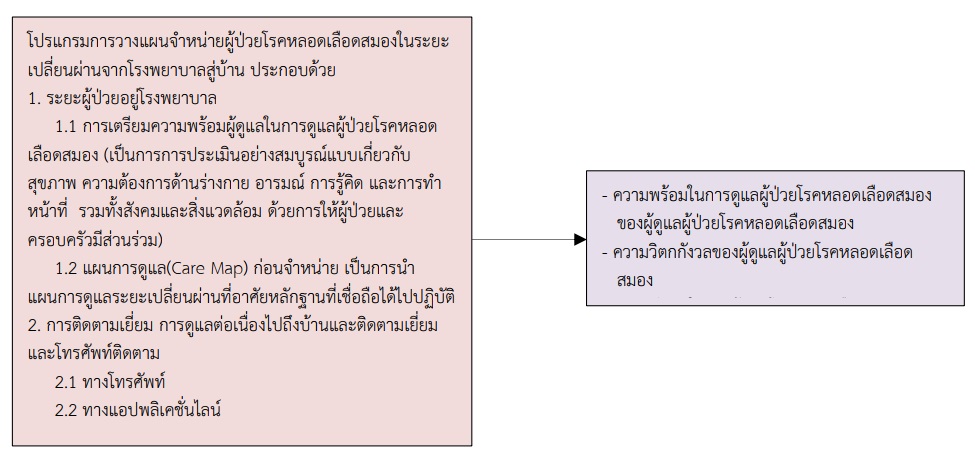ผลการใช้โปรแกรมการวางแผนจำหน่ายผู้ป่วยโรคหลอดเลือดสมองในระยะเปลี่ยนผ่าน จากโรงพยาบาลสู่บ้านต่อความพร้อมในการดูแลก่อนกลับบ้าน ความวิตกกังวล และความพึงพอใจของผู้ดูแลผู้ป่วยโรคหลอดเลือดสมอง โรงพยาบาลสุราษฎร์ธานี
คำสำคัญ:
โปรแกรมการวางแผนจำหน่าย, ผู้ป่วยโรคหลอดเลือดสมองในระยะเปลี่ยนผ่าน, ความพร้อมในการดูแลก่อนกลับบ้านบทคัดย่อ
งานวิจัยกึ่งทดลองนี้มีวัตถุประสงค์เพื่อเปรียบเทียบความพร้อม ความวิตกกังวล และความพึงพอใจในการดูแลก่อนกลับบ้านของผู้ดูแลที่ได้รับโปรแกรมการวางแผนจำหน่ายผู้ป่วยโรคหลอดเลือดสมองในระยะเปลี่ยนผ่านจากโรงพยาบาลสู่บ้าน โรงพยาบาลสุราษฎร์ธานี เครื่องมือวิจัยเป็นโปรแกรมการวางแผนจำหน่ายผู้ป่วยโรคหลอดเลือดสมอง โดยใช้กรอบแนวคิดรูปแบบการดูแลระยะเปลี่ยนผ่านของเนเลอร์และคณะ (Naylor, Brooten, Campbell, Maislin, McCauley, & Schwartz, 2004) เก็บรวบรวมข้อมูลด้วยแบบประเมินความพร้อมในการดูแลผู้ป่วยโรคหลอดเลือดสมอง แบบวัดความวิตกกังวล และแบบประเมินความพึงพอใจ วิเคราะห์ข้อมูลด้วยค่าเฉลี่ย ร้อยละ และสถิติ The Wilcoxon Signed - Rank Test ผลวิจัยพบว่า
คะแนนเฉลี่ยความพร้อมในการดูแลของผู้ดูแลผู้ป่วยโรคหลอดเลือดสมอง หลังได้รับโปรแกรมการวางแผนจำหน่ายผู้ป่วยโรคหลอดเลือดสมองในระยะเปลี่ยนผ่านจากโรงพยาบาลสู่บ้าน สูงกว่าก่อนได้รับโปรแกรมฯ อย่างมีนัยสำคัญทางสถิติที่ระดับ .05 และค่าเฉลี่ยความวิตกกังวลของผู้ดูแลผู้ป่วยโรคหลอดเลือดสมองหลังได้รับโปรแกรมการวางแผนจำหน่ายฯ มีค่าเฉลี่ยลดลงกว่าก่อนได้รับโปรแกรมฯ อย่างมีนัยสำคัญทางสถิติที่ระดับ .05 และความพึงพอใจของผู้ดูแลผู้ป่วยโรคหลอดเลือดสมองที่ได้รับโปรแกรมฯอยู่ในระดับมาก
จากผลการศึกษาครั้งนี้ จะเป็นแนวปฏิบัติการส่งเสริมความพร้อมในการดูแลผู้ป่วยโรคหลอดเลือดสมองที่ได้รับการวางแผนจำหน่ายก่อนกลับบ้าน เพื่อพัฒนาคุณภาพการบริการพยาบาลและส่งเสริมคุณภาพชีวิตของผู้ป่วยโรคหลอดเลือดสมอง
เอกสารอ้างอิง
American Stroke Association. (2015). Heart Disease and Stroke Statistics-At-a-Glance. Retrieved November 23, 2021 from: https://www.heart.org/idc/groups/ucm_470704.pdf.
Andrew, N., Kilkenny, M., Naloy, T., Purvis, T. & Cadilhac, A. D. (2015). The Relation Between Caregiver Impacts and the Unmet Needs of Survivor Stroke. Patient Prefer Adherence, 9, 1065-1073. doi: 10.2147/PPA.S85147.
Chunhabirde, A., Supanuant, T., Oupara, R. & Thongsai, S. (2012). Stress and Needs of Caregivers Providing Care for Stroke Patients and Home. The Journal of Prapokklao Nursing College, 24(1), 1-9. (in Thai)
Division of Non Communication. (2021). Report 2019. Retrieved November 23, 2021 from: http://www.thaincd.com/2016/media.php?tid=30&gid=1-015.
Foust, J. B. (2007). Discharge Planning as Part of daily Nursing Practice. Applied Nursing Research, 20(1),72-77.
Hafsteinsdottir, T. B., Vergunst, M., Lindeman, E. & Schuurmans, M. (2011). Educational Needs of Patients with a Stroke and Their Caregiver: A Systematic Review of the Literature. Patient Education and Counseling, 85(1), 14-25. doi:10.1016/j.pec.2010.07.046.
Hayashi, Y., Hai, H. & Tai, N. A. (2013). Assessment of the Needs of Caregivers of Stroke Patient at State- Owned Acute- Care Hospitals in Southern Vietnam. Public health Research, 10(1), 1-9. doi: 10.5888/pcd10.130023
Intarasombat, P., Monkong, P., Churaitatsanee, S., Vongterapak, S., Prasanaikom, W., Pronsawatchai, P. & Sereewichayasawad, N. (2013). Comprehensive Care of Hospitalized older Adults: Transitional Care from Hospital to Home. Rama Nurs J, 19(2), 194-205. (in Thai)
Kasornsunt, P. (2018). A Transitional Care Model for Stroke Patients at Chaopraya Yommarat Hospital Nursing Journal of the Ministry of Public Health, 25(1), 83-96. (in Thai)
Kerr, P. (2012). Stroke Rehabilitation and Discharge Planning. Nursing Standard, 27(1), 35-39.
Maclsacc, L., Margaret, B., & Godfrey, (2020) C. Supportive Care Needs of Caregivers of Individuals Following Stroke: A Synopsis of Research. Canadian Journal of Neuroscience Nursing, 32(1), 39-46.
Monkong, S., SiriphoNgam, Y., & Leelacharas, S. (2019). Effectiveness of Transitional Care Program for Stroke Patients and Family Care givers from Hospital to Home. Journal of Public Health Nursing, 30(3), 84-101. (in Thai)
Moonthee, M., Monkong, S., Sirapo-ngam, Y., & Leelacharas, S. (2016). Impact of Transitional Care Programme and Family Caregivers on Stroke Patients’ Routine Activity Performance, Complications, and Satisfaction. Thai Journal of Nursing Council, 31(1), 95-110. (in Thai)
National Stroke Association. (2014). Heart Disease and Stroke Statistics- AT-a-Glance. Retrieved November 23, 2021 from: https://www.heart.org/idc/groups/ahamahpublic/@wcm/@sop/@smd/documents/downloadable/ucm_470704.pdf.
Naylor, M. D., Brooten, D. A., Campbell, R. L., Maislin, G., McCauley, K. M., & Schwartz, J. S. (2004). Transitional Care of Older Adults Hospitalized with Heart Failure: a Randomized, Controlled Trial. J Am Geriatr Soc. 52(5), 675-684.
Nuntakarn, P. N., Sirapo-ngam, Y., Monkong, S. & Leelacharas, S. (2016). Effects of a Transitional Care Program for Stroke Patients and Family Caregivers on Caregiver’s Preparedness, Stress, Adaptation, and Satisfaction. Rama Nurs J, 65-80. (in Thai)
Panyaprachoom, P. (2019). The Factors Related to Seeking Treatment at The Hospital Using a Stroke Fast Tract referral network system with acute Stroke Patients. Thammasat Medical Journal, 17(4), 540-547. (in Thai)
Stroke Association. (2015). Depress After Stroke. Retrieved November 23, 2021 from: http/:www.stroke.org.uk/about/depression.
Stuart, G. W. (2013). Principles and Practice of Psychiatric Nursing. 10thed. St. Louis: Elsevie.
Walsh, M. E., Galvin, R., Loughnane, C., Macey, C. & Horgan, N. F. (2015). Community Re-Integration and Long-Term Need in the First Five Years After Stroke: Results from a National Survey. Disability and Rehabilitation, 37(20), 1834-1838. doi:10.3109/09638288.2014.981302.,
World Health Organization. (2012). What is stroke?. Retrieved November 23, 2021 from: http://www.worldstrokecampaign.org/Facts/ Pages/WhatisStroke.aspx.

ดาวน์โหลด
เผยแพร่แล้ว
ฉบับ
ประเภทบทความ
สัญญาอนุญาต
ลิขสิทธิ์ (c) 2023 วารสารการพยาบาลและการศึกษา

อนุญาตภายใต้เงื่อนไข Creative Commons Attribution-NonCommercial-NoDerivatives 4.0 International License.





